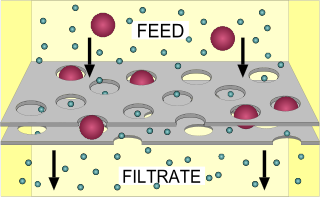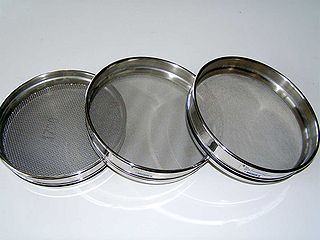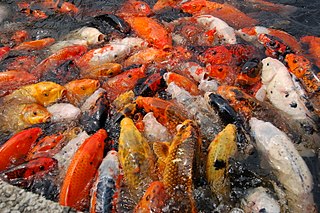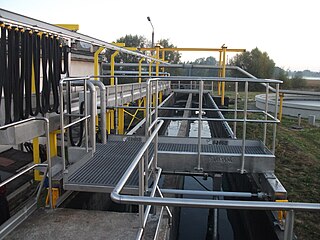
Filtration is a physical separation process that separates solid matter and fluid from a mixture using a filter medium that has a complex structure through which only the fluid can pass. Solid particles that cannot pass through the filter medium are described as oversize and the fluid that passes through is called the filtrate. Oversize particles may form a filter cake on top of the filter and may also block the filter lattice, preventing the fluid phase from crossing the filter, known as blinding. The size of the largest particles that can successfully pass through a filter is called the effective pore size of that filter. The separation of solid and fluid is imperfect; solids will be contaminated with some fluid and filtrate will contain fine particles. Filtration occurs both in nature and in engineered systems; there are biological, geological, and industrial forms. In everyday usage the verb "strain" is more often used; for example, using a colander to drain cooking water from cooked pasta.

Water treatment is any process that improves the quality of water to make it appropriate for a specific end-use. The end use may be drinking, industrial water supply, irrigation, river flow maintenance, water recreation or many other uses, including being safely returned to the environment. Water treatment removes contaminants and undesirable components, or reduces their concentration so that the water becomes fit for its desired end-use. This treatment is crucial to human health and allows humans to benefit from both drinking and irrigation use.

A sieve, fine mesh strainer, or sift, is a tool used for separating wanted elements from unwanted material or for controlling the particle size distribution of a sample, using a screen such as a woven mesh or net or perforated sheet material. The word sift derives from sieve.

A media filter is a type of filter that uses a bed of sand, peat, shredded tires, foam, crushed glass, geo-textile fabric, anthracite, crushed granite or other material to filter water for drinking, swimming pools, aquaculture, irrigation, stormwater management, oil and gas operations, and other applications.
A disc filter is a type of water filter used primarily in irrigation, similar to a screen filter, except that the filter cartridge is made of a number of plastic discs stacked on top of each other like a pile of poker chips. Each disc is covered with small grooves or bumps. The discs each have a hole in the middle, forming a hollow cylinder in the middle of the stack. The water passes through the small passages in between and the impurities are trapped behind.
Ultra-high vacuum is the vacuum regime characterised by pressures lower than about 1×10−6 pascals. UHV conditions are created by pumping the gas out of a UHV chamber. At these low pressures the mean free path of a gas molecule is greater than approximately 40 km, so the gas is in free molecular flow, and gas molecules will collide with the chamber walls many times before colliding with each other. Almost all molecular interactions therefore take place on various surfaces in the chamber.

Sand filters are used as a step in the water treatment process of water purification.

In terms of water treatment, including water purification and sewage treatment, backwashing refers to pumping water backwards through the filters media, sometimes including intermittent use of compressed air during the process. Backwashing is a form of preventive maintenance so that the filter media can be reused. In water treatment plants, backwashing can be an automated process that is run by local programmable logic controllers (PLCs). The backwash cycle is triggered after a set time interval, when the filter effluent turbidity is greater than a treatment guideline or when the differential pressure across the filter exceeds a set value.

An irrigation sprinkler is a device used to irrigate (water) agricultural crops, lawns, landscapes, golf courses, and other areas. They are also used for cooling and for the control of airborne dust. Sprinkler irrigation is the method of applying water in a controlled manner in way similar to rainfall. The water is distributed through a network that may consist of pumps, valves, pipes, and sprinklers.

Koi ponds are ponds used for holding koi carp, usually as part of a garden. Koi ponds can be designed specifically to promote health and growth of the Nishikigoi or Japanese Ornamental Carp. Koi ponds or lakes are a traditional feature of Japanese gardens, but many hobbyists use special ponds in small locations, with no attempt to suggest a natural landscape feature.

The rapid sand filter or rapid gravity filter is a type of filter used in water purification and is commonly used in municipal drinking water facilities as part of a multiple-stage treatment system. These systems are complex and expensive to operate and maintain, and therefore less suitable for small communities and developing nations.

An oil filter is a filter designed to remove contaminants from engine oil, transmission oil, lubricating oil, or hydraulic oil. Their chief use is in internal-combustion engines for motor vehicles, powered aircraft, railway locomotives, ships and boats, and static engines such as generators and pumps. Other vehicle hydraulic systems, such as those in automatic transmissions and power steering, are often equipped with an oil filter. Gas turbine engines, such as those on jet aircraft, also require the use of oil filters. Oil filters are used in many different types of hydraulic machinery. The oil industry itself employs filters for oil production, oil pumping, and oil recycling. Modern engine oil filters tend to be "full-flow" (inline) or "bypass".

A tube well is a type of water well in which a long, 100–200 millimetres (3.9–7.9 in)-wide, stainless steel tube or pipe is bored underground. The lower end is fitted with a strainer, and a pump lifts water for irrigation. The required depth of the well depends on the depth of the water table.
In plumbing, a sink strainer is a type of perforated metal sieve or mesh strainer used to strain or filter out solid debris in the water system. Different varieties are used in residential premises and for industrial or commercial applications. Such strainer elements are generally made from stainless steel for corrosion resistance.

Taprogge GmbH is a medium-sized company based in Wetter, Germany. The company is named after founding brothers Ludwig and Josef Taprogge. Founded in 1953, the company is known for its tube cleaning systems for steam turbine condensers, heat exchangers and debris filters for water-cooled shell and tube heat exchangers and condensers.

A sand separator is a device that separates sand or other solids from water.
Depth filters are filters that use a porous filtration medium to retain particles throughout the medium, rather than just on the surface of the medium. Depth filtration, typified by multiple porous layers with depth, is used to capture the solid contaminants from the liquid phase. These filters are commonly used when the fluid to be filtered contains a high load of particles because, relative to other types of filters, they can retain a large mass of particles before becoming clogged.
Spa filters work continuously to keep debris and sediments from the water in a spa pool.
Ultrapure water (UPW), high-purity water or highly purified water (HPW) is water that has been purified to uncommonly stringent specifications. Ultrapure water is a term commonly used in manufacturing to emphasize the fact that the water is treated to the highest levels of purity for all contaminant types, including: organic and inorganic compounds; dissolved and particulate matter; volatile and non-volatile; reactive, and inert; hydrophilic and hydrophobic; and dissolved gases.

Gravity filtration is a method of filtering impurities from solutions by using gravity to pull liquid through a filter. The two main kinds of filtration used in laboratories are gravity and vacuum/suction. Gravity filtration is often used in chemical laboratories to filter precipitates from precipitation reactions as well as drying agents, inadmissible side items, or remaining reactants. While it can also be used to separate out strong products, vacuum filtration is more commonly used for this purpose.














